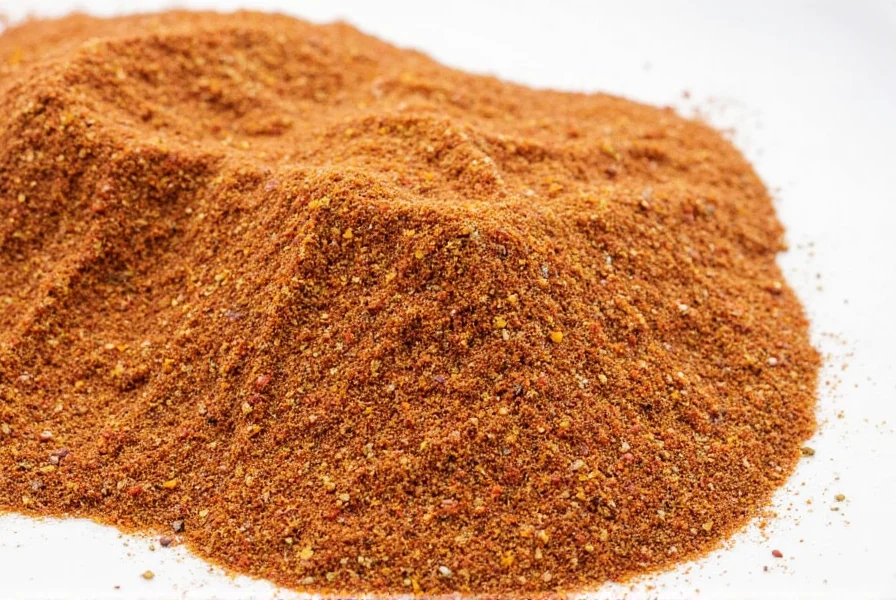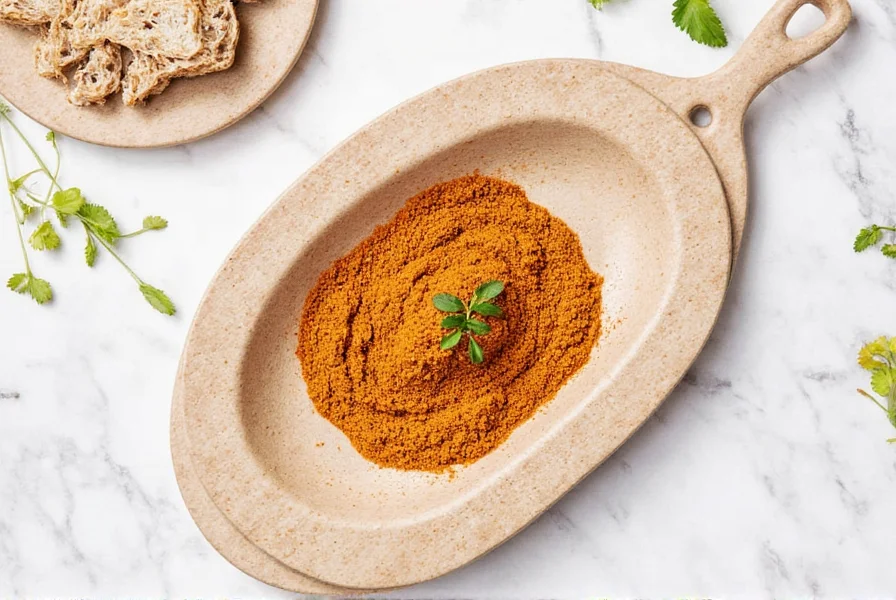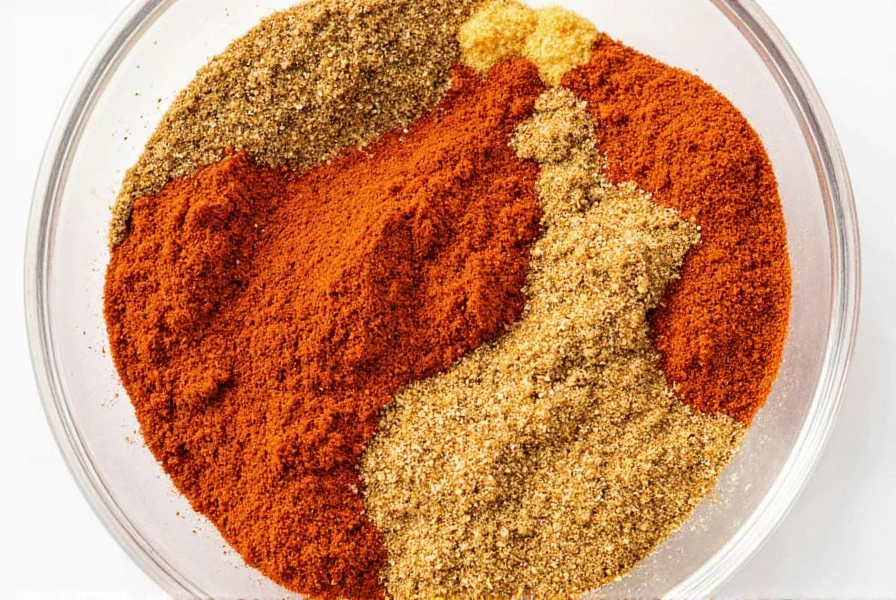Table of Contents
What Is Creole Seasoning? (Direct Definition)
Creole seasoning is a distinctive spice blend originating from New Orleans that combines garlic, onion, paprika, and herbs like thyme and oregano with a balanced level of heat from cayenne pepper. Unlike many commercial spice mixes, authentic Creole seasoning features a harmonious blend of aromatic spices rather than overwhelming heat, making it versatile for various dishes from seafood to vegetables.

This Louisiana-born seasoning differs from its Cajun counterpart by being more herb-forward with moderate heat, while Cajun seasoning emphasizes spiciness. The traditional Creole blend typically contains 7-9 core ingredients that work together to create complex flavor profiles essential to dishes like gumbo, jambalaya, and étouffée.
Complete Ingredient Breakdown
Authentic Creole seasoning consists of these essential components in precise ratios that create its signature flavor profile:
- Garlic powder (20%) – Provides foundational savory depth without raw garlic's sharpness
- Onion powder (18%) – Adds sweet, mellow base notes that complement other spices
- Sweet paprika (15%) – Contributes color and subtle sweetness without smoke
- Dried thyme (12%) – Offers earthy, floral undertones characteristic of Creole cooking
- Dried oregano (10%) – Brings Mediterranean herbal notes that distinguish it from Cajun
- Cayenne pepper (8%) – Provides gentle heat (adjustable to taste)
- Black pepper (7%) – Enhances overall flavor complexity
- Salt (10%) – Balances and amplifies other flavors
Professional chefs often add celery seed (3%) and white pepper (2%) for additional complexity in restaurant-grade blends. The precise ratio matters—too much cayenne makes it Cajun-style, while insufficient herbs loses the Creole identity.

Creole vs. Cajun: Clear Comparison
Understanding the difference between these often-confused seasonings is crucial for authentic Louisiana cooking. Here's the definitive breakdown:
| Characteristic | Creole Seasoning | Cajun Seasoning |
|---|---|---|
| Origin | Urban New Orleans (French Quarter) | Rural Acadiana (Cajun Country) |
| Primary Flavor Profile | Herb-forward with balanced heat | Pepper-forward with intense heat |
| Key Distinguishing Ingredients | Thyme, oregano, paprika | Cayenne, black pepper, garlic |
| Heat Level (Scoville Scale) | 500-1,500 units (mild to medium) | 2,000-5,000 units (medium to hot) |
| Traditional Applications | Seafood, tomatoes, light meats | Game meats, beans, root vegetables |
| Cultural Heritage | French/Spanish/African influences | Acadian (French Canadian) roots |
The most reliable way to distinguish them? If thyme and oregano dominate the aroma, it's Creole. If your eyes water from the initial scent, it's Cajun. Many commercial blends mislabel these, so checking ingredient lists is essential for authentic results.

Practical Usage Guide
Maximize your Creole seasoning's potential with these chef-recommended techniques:
Professional Application Methods
- Dry brining meats: Apply 1 tsp per pound of protein 2 hours before cooking for deep flavor penetration
- Building flavor bases: Sauté 2 tsp with onions and celery (the "holy trinity") before adding liquids
- Finishing touch: Sprinkle ¼ tsp over finished dishes for aromatic freshness
- Marinade accelerator: Combine with buttermilk (½ cup buttermilk + 1 tbsp seasoning) for tenderizing
- Vegetable enhancement: Toss 1 tsp with 2 cups roasted vegetables during last 10 minutes of cooking
Measurement Guidelines
- For 4 servings: 1-1.5 tsp (reduces additional salt by ¼ tsp)
- For soups/stews: 1 tbsp per quart (add during last 30 minutes of cooking)
- For dry rubs: 2 tbsp per pound of meat (combine with 1 tbsp oil)
- For sauces/dips: 1 tsp per cup of base (mayonnaise, sour cream, tomato sauce)
Avoid adding Creole seasoning to boiling liquids—the delicate herb flavors dissipate quickly. For best results, add during the last 15-20 minutes of cooking or as a finishing touch.

Proper Storage Methods
Maintain your Creole seasoning's potency with these storage techniques:
- Air-tight containers: Use glass jars with rubber seals (plastic absorbs oils)
- Dark storage: Keep in opaque containers or dark cabinets (light degrades paprika)
- Temperature control: Store below 70°F (21°C)—never near stoves or ovens
- Moisture prevention: Include silica packets in storage containers
- Shelf life: 6 months for homemade, 12-18 months for commercial blends
Test freshness by rubbing ¼ tsp between fingers—if aroma is weak or musty, replace. Never store in refrigerator (causes clumping from humidity). For extended storage, freeze in vacuum-sealed bags (thaw completely before use to prevent condensation).

Frequently Asked Questions
What defines authentic Creole seasoning?
Authentic Creole seasoning must contain thyme and oregano as prominent ingredients (minimum 8% combined), with paprika as the primary colorant. It should have balanced heat (cayenne comprising 5-10% of the blend) and derive its salt content from natural sources. The distinctive characteristic is its herb-forward profile rather than heat dominance.
Why does my Creole seasoning taste different from New Orleans versions?
Commercial blends often substitute cheaper ingredients. Authentic New Orleans Creole seasoning uses specific paprika varieties (often Hungarian sweet) and fresh-ground herbs. The critical difference is in the thyme-to-oregano ratio (typically 3:2 in authentic blends) and the inclusion of celery seed. For true flavor, use a blend with no fillers or anti-caking agents.
Can I substitute Creole seasoning for Cajun in recipes?
Yes, but with adjustments: use 25% more Creole seasoning and add ⅛ tsp cayenne per teaspoon substituted. Remember that Creole's herbal notes won't replicate Cajun's pepper-forward profile exactly. For gumbo, étouffée, or seafood dishes, Creole is actually preferable. For game meats or bean dishes, stick with Cajun or boost the heat.
Does Creole seasoning contain MSG or preservatives?
Traditional Creole seasoning contains neither. Authentic blends consist solely of dried spices and salt. Check labels for additives—quality commercial brands like Tony Chachere's Original and Zatarain's Pure Filé contain only natural ingredients. Avoid blends listing "spice extracts" or "natural flavors" as these often contain MSG derivatives.
How can I adjust Creole seasoning for dietary restrictions?
For salt-free versions: replace salt with rice flour (1:1 ratio) and add ¼ tsp potassium chloride for flavor balance. For enhanced heat: increase cayenne by 50% and add ⅛ tsp chipotle powder. For reduced heat: decrease cayenne by 50% and increase paprika proportionally. Always adjust in small increments and allow 24 hours for flavors to meld.











 浙公网安备
33010002000092号
浙公网安备
33010002000092号 浙B2-20120091-4
浙B2-20120091-4